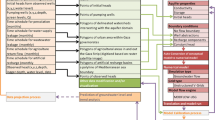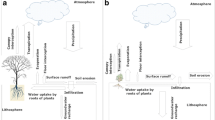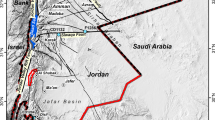Abstract
The impact of land-use on distributed groundwater recharge and discharge in the western Jilin (WJ) was analyzed in this study. WJ is a transitional, semi-arid zone with a fragile, hydrological closed ecosystem in the Songhua River Basin (SRB). The research tool includes a seamlessly linked MODFLOW, WetSpass, the Seepage packages, and ArcGIS. The model calibration showed good agreement between simulated water table elevation and measured water table depths, while predicted groundwater discharge zones showed strong correlations with field occurrences of drainage systems and wetlands. Simulated averages for distributed recharge, water table elevation and groundwater drawdown were 377.42mm/yr, 194.43m, and 0.18m respectively. Forest vegetation showed the highest recharge, followed by agricultural farmlands, while open-water and other drainage systems constituted groundwater exit zones. When present land-use conditions were compared with the hypothetical natural pre-development scenario, an overall loss of groundwater recharge (24.09mm/yr) was observed, which for the project area is 18.05 × 108m3. Groundwater abstraction seemed to be the cause of water table drawdown, especially in the immediate vicinities of the supply wells. An important issue of the findings was the ability of the hypothetical forest vegetation to protect, and hence sustain aquifer reserves and dependent ecosystems. The profound data capture capability of ArcGIS makes it particularly useful in spatio-temporal hydroecological modeling.
Similar content being viewed by others
References
Adegoke J O, Pielke R A, Eastman J et al., 2003. Impact of irrigation on midsummer surface fluxes and temperature under dry synoptic conditions: a regional atmospheric model study of the US High Plains. Monthly Weather Review, 131: 556–564.
Asefa T, Wang Z, Batelaan O et al., 1999. Open integration of a spatial water balance model and GIS to study the response of a catchment. In: Morel-Seytoux H J (ed.). Proceedings of the 19th Annual American Geophysical Union Hydrology Days. Colorado, US EPA: Fort Collins, 11–22.
Batelaan O, De Smedt F, 1998. An adapted DRAIN package for seepage problems. In: Poeter E et al. (eds.). MODFLOW’98 Proceedings. vol. II. US EPA. Colorado School of Mines, Golden, CO, 555–562.
Batelaan O, De Smedt F, 2001. WetSpass: a flexible, gis based, distributed recharge methodology for regional groundwater modeling. In: Gehrels H et al. (eds.). Impact of Human Activity on Groundwater Dynamics. Publ. No. 269. Wallingford, UK: IAHS Press, 11–17.
Batelaan O, De Smedt F, De Becker P et al., 1998. Characterization of a regional groundwater discharge area by combined analysis of hydrochemistry, remote sensing and groundwater modeling. In: Dillon et al. (eds.). Shallow Groundwater Systems, International Contributions to Hydrogeology. Netherlands: Balkema, Rotterdam Press, No. 18: 75–86.
Batelaan O, Wang Z M, De Smedt F, 1996. An adaptive GIS toolbox for hydrological modelling. In: Kovar K et al. (eds.), Application of Geographic Information Systems in Hydrology and Water Resources Management. Wallingford, UK: IAHS Press, No. 235: 3–9.
Batelaan O, De Smeldt F, Triest L, 2003. Regional groundwater discharge: phreatophyte mapping, groundwater modelling and impact analysis of land-use change. Journal of Hydrology, 275: 86–108.
Bernàldez F G, Rey B J M, Martinez A, 1993. Ecological impact of groundwater extraction on wetlands (Douro Basin, Spain). Journal of Hydrology, 141: 219–238.
Boeye D, Verheyen R F, 1992. The hydrological balance of a groundwater discharge fen. Journal of Hydrology, 137: 149–163.
Cook P G, Walker G R, Jolly I D, 1989. Spatial variability of groundwater recharge in a semiarid region. Journal of Hydrology, 111: 195–212.
De Smedt F, Yongbo L, Gebremeskel S, 2000. Hydrologic modelling on a catchment scale using gis and remote sensed land use information. In: Brebbia C A (ed.). Risk Analyses II. Southampton, Boston, USA: WIT Press, 295–304.
Domenico P A, Schwartz F W, 1990. Physical and Chemical Hydrogeology. New York, NY, USA: John Wiley & Sons.
Fels J E, Matson K C, 1996. A cognitively-based approach for hydrogeomorphic land classification using digital terrain models. In: Proceedings of Third International Conference on Integrating GIS and Environmental Modeling. New York: Oxford University Press.
Franke L O, Reilly T E, Bennet G D, 1984. Definition of boundary and initial conditions in the analysis of saturated ground-water flow systems—An introduction. US Geological Survey Open-File Report, 84-458: 26.
Harbaugh A W, 2005. MODFLOW-2005, the U.S. Geological Survey Modular Ground-water Model—The Ground-Water Flow Process. US Geological Survey Techniques and Methods, 6-A16.
Harbaugh A W, McDonald M G, 1996. User’s documentation for MODFLOW-96, an update to the US Geological Survey modular finite-difference ground-water flow model. US Geological Survey Open-File Report, 96-485: 56.
Himiyama Y, Ito H Honma T, Kikuchi T, 1995. Land use in North-East China in the 1930s. Reports of the Taisetsuzan Institute of Science, No. 30: 25–35.
Izbicki J A, 2002. Geologic and hydrologic controls on the movement of water through a thick, heterogeneous unsaturated zone underlying an intermittent stream in the western Mojave Desert, southern California. Water Resources Research, 38: 1–14.
King F H, 1899. Principles and conditions of the movements of groundwater. US Geological Survey 19th Annual Report, Part 2: 59–294.
McMahon P B, Dennehy K F, Ellett K M et al., 2003. Water movement through thick unsaturated zones overlying the central High Plains aquifer, southwestern Kansas, 2000–2001. USGS Water Resources Investigation Report, 03-4171: 32
Moore N, Rojstaczer S, 2002. Irrigation’s influence on precipitation: Texas High Plains, U.S.A. Geophysical Research Letters, 29: 21–24.
Newman B D, Sala O E, Wilcox B P, 2003. Conference promotes study of ecohydrology of semi-arid landscapes. EOS, Transactions, American Geophysical Union, 84: 13, 17.
Phillips F M, 1994. Environmental tracers for water movement in desert soils of the American Southwest. Soil Science Society of America Journal, 58: 14–24.
Pucci A A, Jr. Pope D A, 1995. Simulated effects of development on regional ground-water/surface-water interactions in the northern Coastal Plain of New Jersey. Journal of Hydrology, 167: 241–262.
Roark D M, Healy D F, 1998. Quantification of deep percolation from two flood-irrigated alfalfa fields, Roswell Basin, New Mexico. US Geological Survey Water Resources Investigation Report, 98-4096: 32.
Rodriguez-Iturbe I, 2000. A hydrologic perspective of climate-soil-vegetation dynamics. Water Resources Research, 36: 3–9.
Tilman D, Fargione J, Wolff B et al., 2001. Forecasting agriculturally driven global environmental change. Journal of Science, 292: 281–284.
Tyler S W, Chapman J B, Conrad S H et al., 1996. Soil-water flux in the southern Great Basin, United States: temporal and spatial variations over the last 120,000 years. Water Resources Research, 32: 1481–1499.
Vandewiele G L, Xu C-Y, Ni Lar-Win, 1991. Methodology for Constructing Monthly Water Balance Models on Basin Scale, Booklet. Free University Brussels, Belgium: Published by Laboratory of Hydrology and Centre for Statistics and Operational Research, 57.
Vorosmarty C, Lettenmaier D, Leveque C et al., 2004. Humans transforming the global water system. Eos., 85: 509–520.
Wang Z M, Batelaan O, De Smedt F, 1997. A distributed model for water and energy transfer between soil, plants and atmosphere (WetSpass). Phys. Chem. Earth, 21(3): 189–193.
Author information
Authors and Affiliations
Additional information
Biography: Moiwo Juana PAUL (1967–), male, a native of Sierra Leone of West Africa, Ph.D. candidate, specialized in wetland ecology.
Rights and permissions
About this article
Cite this article
Paul, M.J. Impact of land-use patterns on distributed groundwater recharge and discharge. Chin. Geograph.Sc. 16, 229–235 (2006). https://doi.org/10.1007/s11769-006-0229-5
Received:
Accepted:
Issue Date:
DOI: https://doi.org/10.1007/s11769-006-0229-5




